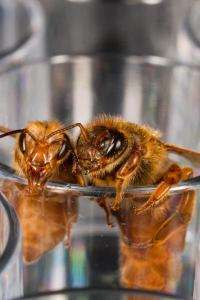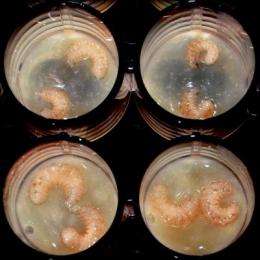Protein love triangle key to crowning bees queens?

A honey bee becomes a royal queen or a common worker as a result of the food she receives as a larva. While it has been well established that royal jelly is the diet that makes bees queens, the molecular path from food to queen is still in dispute. However, scientists at Arizona State University, led by Adam Dolezal and Gro Amdam, have helped reconcile some of the conflicts about bee development and the role of insulin pathways and partner proteins. Their article "IIS and TOR nutrient-signaling pathways act via juvenile hormone to influence honey bee cast fate" has been published in the December issue of the Journal of Experimental Biology.
Central to the dispute within the scientific community about "who would be queen" has been a ground-breaking study published in the journal Nature by Japanese scientist Masaki Kamakura in 2011. He found that a single protein in royal jelly, called royalactin, activated queen development in larval bees through interaction with an epidermal growth factor receptor (EGFR). Kamakura's work suggested that insulin signals do not play a role in queen development, despite previous studies suggesting otherwise, including work pioneered with the insulin receptor protein by Amdam's group.
Undeterred by Kamakura's findings, Dolezal, a doctoral student, and Amdam, a Pew Biomedical Scholar and professor in ASU's School of Life Sciences, looked for ways to resolve the disparity between the research studies. Amdam's team's first step involved taking control of the insulin receptor's partner protein, IRS, which the insulin receptor relies upon for signaling. The scientists found that by blocking IRS, they caused a central developmental hormone to crash, which forced larval bees into the worker mold despite their diet of royal jelly. Amdam's team then "rescued" the now worker-destined bees. They found that by giving the bees hormone treatments, the bees could then develop along the queen trajectory.

However, while Dolezal and Amdam's studies showed that they could block queen development, and then rescue it, and clarified the role of IRS in the queen-making process, their work could not resolve the remaining conflict with Kamakura's results.
Taking a new tack, the Amdam group, which also included Navdeep Mutti, Florian Wolschin, and Jasdeep Mutti, and Washington State University scientist Kulvinder Gill, turned to mathematical modeling, combining their results with approaches that analyze potential partner interactions. These models, developed to understand and clarify complex relationships in physics and biology, allowed the ASU researchers to build a model of consensus – explaining how the IRS partner protein could partner to both epidermal growth factor receptor and the insulin receptor. And while the insulin receptor itself may play no role – as Kamakura's findings suggest – Dolezal and Amdam's findings show that the IRS partner protein may in fact be key to a molecular love triangle, interacting with both receptors, and with the bond to epidermal growth factor receptor being the crowning feature in queen development.
Provided by Arizona State University



















